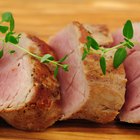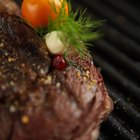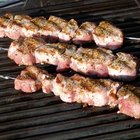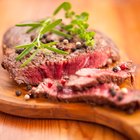
Both the tenderloin filet and top sirloin are highly-prized cuts of steak. Each cut offers its own benefits, however, so consider the steak's strengths when browsing the butcher case. Top sirloins are easy to prepare for a casual weeknight meal, while the tenderloin filet may be best reserved for special occasions.
Strip Steak or Round Filet
Although the name can be confusing, the top sirloin has nothing to do with the sirloin steak. Also known as a New York strip or Kansas City strip, the top sirloin is cut from the area just behind the ribs. The top sirloin is a long, slender cut with excellent marbling and a thick strip of fat running around the edge. The tenderloin filet, commonly labeled as filet mignon, is also cut from the area behind the ribs. This cut is very low in fat and round in shape.
Flavor vs. Texture
Due to its marbling and fat content, the top sirloin is the clear winner when it comes to flavor. All that beautiful fat makes this cut moist and juicy with a strong beef flavor. Because the tenderloin filet has a very low fat content, it has much milder flavor, but what it lacks in flavor it more than makes up for in texture. The tenderloin is very tender and almost melts in your mouth. It is an excellent choice for people looking for a lower fat option.
Weeknight or Special Occasion
The tenderloin is a relatively small cut of meat and is highly prized for its tender texture. The filet in particular can be very pricey and so is often reserved for special occasions. The top sirloin, on the other hand, is a more economical choice, especially considering its excellent flavor.
Cooking Methods
Because of the tenderloin filet's low fat content, it cooks very quickly and is prone to drying out. The tenderloin filet it best cooked to medium-rare, as cooking the steak above medium will cause it to become dry and tough. Try basting the steak with butter as it cooks to make up for the lack of fat. Top sirloin steaks are more forgiving. They're still quite tender, but the fat makes it easy to cook and better suited for medium or medium-well preparations. Both cuts are best when grilled or pan-fried over medium-high heat. Although many chefs and diners alike prefer their steaks cooked to a lower temperature, the USDA recommends cooking all cuts of beef to a minimum internal temperature of 145 degrees Fahrenheit to guarantee safe consumption.
Related Articles

How to Cook Beef Tenderloin With the ...

Filet vs. Strip vs. Sirloin
How to Cook Buffalo Fillet

How to Cook Kobe Steaks

Brisket vs. Tri-Tips

What Is a Rib-Eye Steak?

What Is a Chateau Cut?

How to Cook a 15-Pound Rib Roast
What Is the Best Way to Cook Swordfish?

The Best Way to Prepare Bison Sirloin

Tri Tip Cooking Methods

How to Convection Roast a Brisket

Different Cuts of Steak

How to Cook Pork Loin

How to Cook London Broil

Types of Steak: Rare and Medium Rare

Does a Rib Eye Have a Filet in It?
How to Slow Cook a Top Sirloin Round ...

How to Cook 5 Lbs. of Beef Tenderloin

Is the Rib Eye or Sirloin a Better Cut?
References
Resources
Writer Bio
Irena Eaves began writing professionally in 2005. She has been published on several websites including RedPlum, CollegeDegreeReport.com and AutoInsuranceTips.com. Eaves holds a Bachelor of Science in journalism from Boston University.
Photo Credits
Michael Blann/Digital Vision/Getty Images